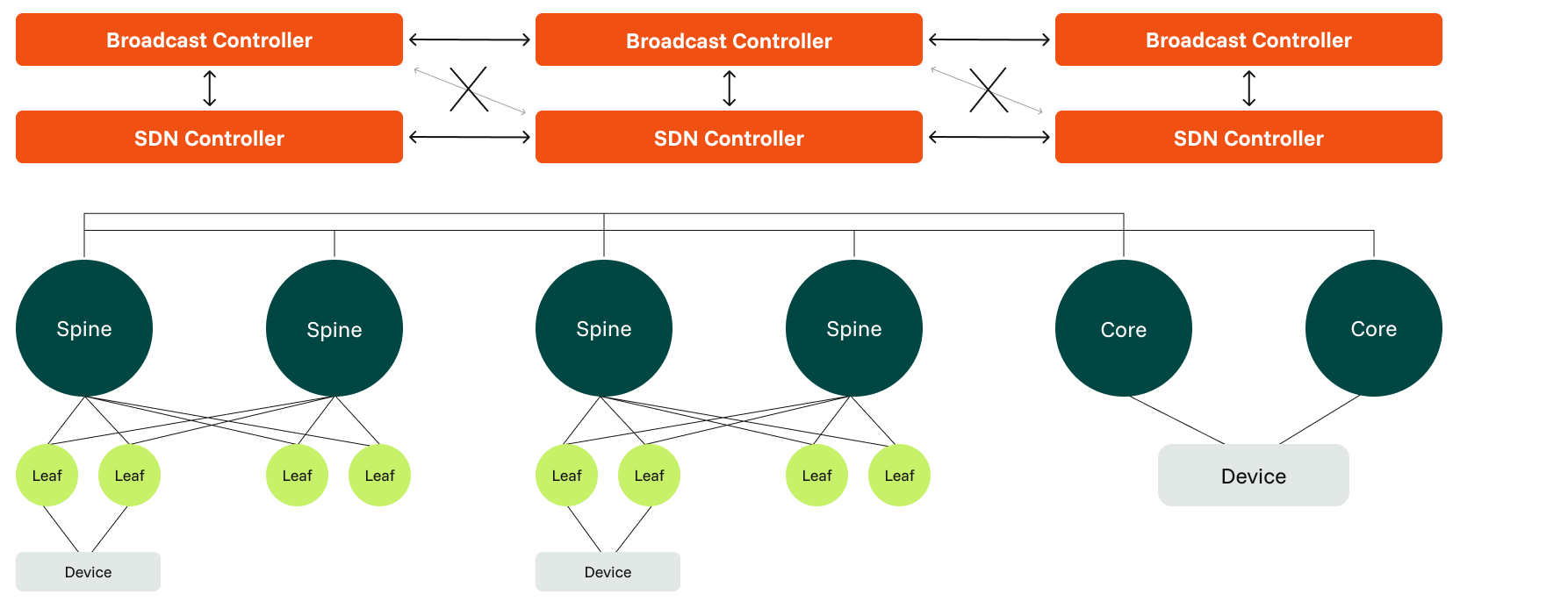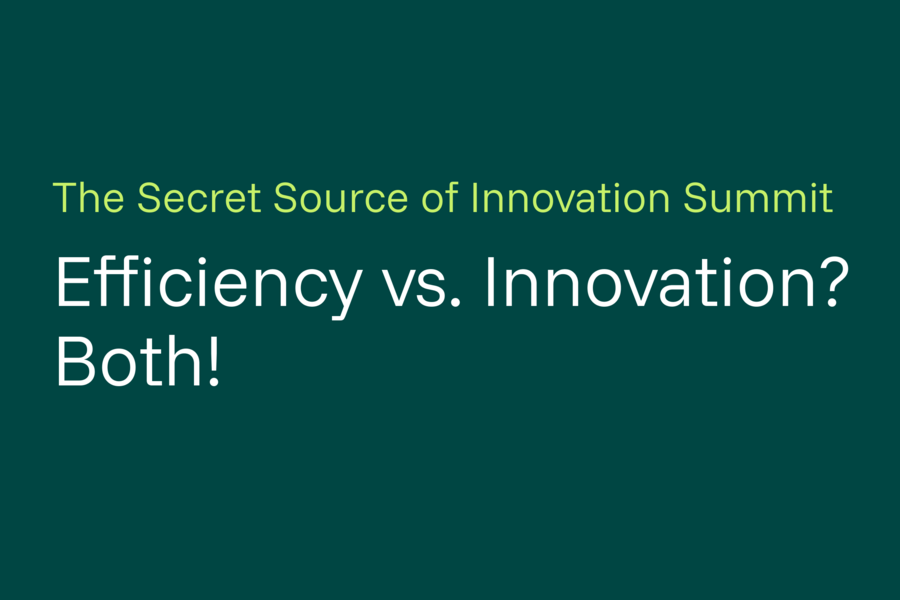Continuous SMPTE ST 2110 flows across system boundaries
How a major broadcaster leverages control systems to minimize business disruptions while maintaining seamless end-to-end workflows with SDN controllers.

How a major broadcaster minimizes the impact of business interruptions by deploying multiple control systems - without sacrificing end-to-end workflow
One of the biggest challenges facing media companies today is the transformation from traditional SDI technology to a modern networked infrastructure for SMPTE ST 2110 production.
The greater flexibility associated with the new system brings with it a greater administrative burden in its use. However, this effort can be very well automated by software. Especially in large environments, a single control system can become the single point of failure. To minimize the consequences of business interruptions, multiple control systems are used. They are combined into a federation to create an end-to-end workflow.
In this white paper, we describe how control systems in a federation manage the transmission of signals from the endpoints and through the network - and limit the consequences of service interruptions.
The challenge
Automation based on software offers many advantages for broadcasters. But it also means that operations are heavily dependent on the functionality of this software. The question that arises above all when the technical infrastructure of a large media production site is to be completely and sustainably transformed: How can the effects of operational interruptions - caused, for example, by a spontaneous error or planned maintenance work - be limited in the central control components?
First of all, there are the familiar measures at the lowest and middle hardware levels with redundant components (e.g., power supplies, fans and network connections) and subsystems (servers and switches). But what precautions can be taken at the software level?
The cluster systems usually used primarily cover hardware faults. However, they provide little protection against programming or configuration errors - these are transferred to the cluster partner(s) through the installation process (or automatic replication). One way to prevent software errors from completely paralyzing a media company's site: The direct sphere of influence of the individual systems is limited, and separate systems control different areas on site.
However, this approach is at odds with the end-to-end workflows desired with the switch to IP-based systems. One solution is for the individual systems to communicate with each other. The decisive factor here is to avoid too close a coupling and thus too close a dependency between the individual systems. Malfunctions in one system must not have a serious impact on another system.
Nor does it make sense to make all sources (transmitters) and sinks (receivers) available in all areas. Individual areas should be tailored so that as few signals as possible need to be exchanged between them. It will often make sense to draw the boundaries based on the parameters set by the organization. Then the bandwidth of cross-connections between areas can also be reasonably limited. At the same time, the signals made available in other areas can be determined based on the respective organizational responsibility.
This requires a mechanism that makes sources or sinks known to another system. Ideally, this is done dynamically: sources that are not constantly needed in another system or alternately used by different systems can be appropriately made available.
In most cases, sources are made available to other areas so that they can further process the corresponding signals. However, there are also applications in which sinks are to be used by other systems. For example, if a return line is to be provided from a main control room and for a control room, which is to be wired with any signal.
Control levels in SMPTE ST 2110 networks
Three levels of control can be identified in SMPTE ST 2110 networks:
1. BROADCAST CONTROL
This level provides the interface for the user. It contains all the functionalities that allow users to access sources and sinks as easily as possible:
- Speaking names
- Summary of sources and sinks to be switched simultaneously (associations)
- Order structure
In addition, most broadcast controllers (BC) provide other functions such as tally, salvos, and logic; however, they are not relevant in our context.
2. STREAM CONTROL
This level is responsible for configuring the sources and sinks within the SMPTE ST 2110 system.
3. NETWORK CONTROL
This level calculates the paths through the network and gives the appropriate commands to the network devices.
Depending on the system and application design, these levels can be distributed across three different software products. Alternatively, two or all three levels are combined in one software product.
In our consideration for this white paper, we assume a system in which layers two and three are combined in a Software Defined Networking Controller (SDNC). The SDNC is in turn controlled by a broadcast controller. In general, the conclusions can also be applied to other system designs.
Federation
A federation is the loose coupling of several system areas. Each area has its own network infrastructure and its own controllers. Information is exchanged at each level:
- The network is an uninterrupted IP network where SMPTE ST 2110 flows can be transmitted end-to-end.
- The SDNCs exchange information about SDP files, required bandwidth, and cross-connection used.
- The broadcast controllers exchange information about names, associations and order.
Implementation of the layer model in complex systems
When we consider complex systems, it has proven useful to divide the systems into layers (cf. OSI or IETF layer model). All layer models have one thing in common: Each layer provides services for the layer above it on the same instance or in the same system - and uses services of the layer below it. Between different instances or systems, communication takes place only on the same layer. This keeps the number of communication relationships and dependencies relatively low.
In our specific case, this means that there is only communication from BC to BC and from SDNC to SDNC between the different areas - the BC in one area does not communicate with the SDNC in another area.

Requirements in the network
The prerequisite for end-to-end IP connections is a comprehensive network that connects all areas. The alternative would be islands separated by baseband or NAT gateways - but that would lead to even stricter separation and less flexibility. Depending on the size and requirements of each area, the individual systems can have different topologies. As within the systems, the bandwidth on the network lines is managed by the SDNC.
Requirements for the Software Defined Networking Controller
In our example, the SDNC is responsible for the paths in the network and the configuration of sources and sinks. Within a system, the SDNC retrieves the SDP file with the data over the stream from the sender, calculates and configures the path through the network, and delivers the SDP file to the receiver.
In case of a federation the following is additionally required for a connection establishment:
- Transfer of the SDP file from the sender SDNC to the receiver SDNC
- Selection of a cross connection by the sender-SCNC and transfer to the receiver-SNDC
Fill out the form and click "Submit." You will then receive a link via email to download the whitepaper. Please note that email delivery may take a few minutes.











